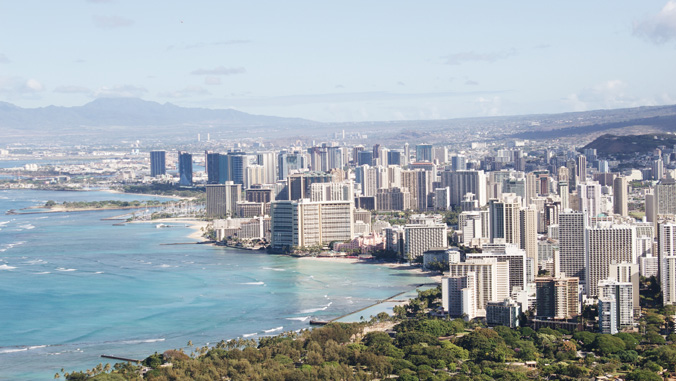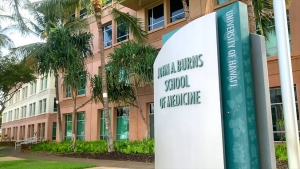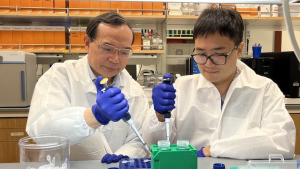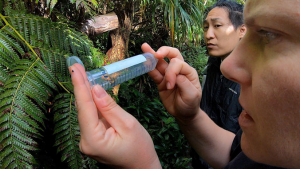
The University of Hawaiʻi at Mānoa is one of the country’s leading universities when it comes to funding from the National Institutes of Health (NIH), the largest public funder of biomedical research in the world. UH Mānoa received $57.8 million in 2023, placing the university at 130 out of 2,886 institutes of higher education, private companies, and other entities that received NIH funding.

“To receive this level of federal support is a testament to the quality of our researchers and health-related research programs and is further proof that UH Mānoa is one of the top research universities in the country,” said UH Mānoa Provost Michael Bruno. “This is research that matters and directly impacts the people of Hawaiʻi and the world.”
The UH Cancer Center accounted for $27 million of the NIH funding UH Mānoa received. The center is one of only 72 research organizations in the U.S. designated by the National Cancer Institute.
This is research that matters and directly impacts the people of Hawaiʻi and the world.
—Michael Bruno
“Our mission is to reduce the burden of cancer here in Hawaiʻi through patient care, community outreach, and research focused on the needs of our unique and ethnically diverse population. We serve the entire community, especially underrepresented ethnic groups,” said UH Cancer Center Director Naoto Ueno. “The NIH support and the fact that we have been NCI-designated for 27 straight years is a testament to our dedicated researchers and staff and their commitment to Hawaiʻi.”

The John A Burns School of Medicine (JABSOM) brought in $26.6 million of the NIH funding, placing JABSOM 87th out of 144 medical schools in 2023 NIH funding. UH Mānoa is No. 1 in NIH funding out of the Research Centers in Minority Institutions (RCMI) with medical schools, established to develop and strengthen the research infrastructure at minority-serving institutions and foster the next generation of researchers from underrepresented populations.
“The JABSOM ʻohana, our community, academic, and healthcare partners are proud to receive this level of federal support because ultimately it all benefits the people of Hawaiʻi and the US Affiliated Pacific Island jurisdictions (USAPI),” said UH Mānoa JABSOM Interim Dean Lee Buenconsejo-Lum. “JABSOM is committed to serving the people of Hawaiʻi and the USAPI, including preparing future physicians and scientists to conduct research that impacts our communities with the most health disparities.”
Further economic impact
NIH funding also has a significant positive economic impact, supporting employment and the purchase of research-related goods, services and materials.

According to an NIH report, UH Mānoa received $57.5 million in funding in 2022, generating $181 million of economic activity in Hawaiʻi responsible for funding 1,228 jobs.
“UH is a major economic engine in Hawaiʻi demonstrating the dual benefit of being one of the top research universities in the country,” said UH Mānoa Vice Provost of Research Christopher Sabine. “In fiscal year 2023, UH Mānoa accounted for $342.7 million of the UH’s record $515.9 million in extramural (federal) funding. This money is used to tackle the issues that Hawaiʻi and the world are facing while also educating our students to be the scientific leaders of the future.”
NIH-funded projects at UH Mānoa include:
- The UH Pacific Center for Genome Research (PCGR) was established to focus on Hawaiʻi’s diverse populations with the goal of better understanding the causes of certain diseases that disproportionately impact different racial and ethnic groups, including Native Hawaiians and Asian Americans (UH Cancer Center and JABSOM). Related UH News story.
- The five-year renewal of the UH Cancer Center Multiethnic Cohort (MEC) Study, the most ethnically diverse epidemiological study in the world that follows 215,000 residents of Hawaiʻi and Southern California for the development of cancer and other chronic diseases.
- HI-INBRE, the Hawaiʻi Institutional Development Award (IDeA) Networks of Biomedical Research Excellence (INBRE) to expand research opportunities in the state and build the foundation for the next generation of biomedical researchers (JABSOM). Related UH News story.
- The UH Cancer Center Specialized Program of Research Excellence (SPORE) aims to bridge the gap between scientific discoveries and their real-world applications. It focuses primarily on addressing cancer health disparities among Asian Americans, Native Hawaiians, and Pacific Islanders.
- Ola HAWAII RCMI Center focuses on “ola” (health) for communities suffering disproportionately from genetic, environmental, and socioeconomic disparities and lead and advance minority health and health disparities research in Hawaiʻi (JABSOM). Related UH News story.
- The The Center for Pacific Innovations, Knowledge, and Opportunities (PIKO) is helping build a statewide clinical and translational research infrastructure to improve the health of Native Hawaiians, other Pacific Islanders and Filipinos that have disproportionately higher rates of physical and mental health conditions, compared to Caucasian and Asians (JABSOM). Related UH News story.
- The Integrative Center for Environmental Microbiomes and Human Health (ICEMHH) to develop three state-of-the-art “cores”—an insectary, a microbial genomics laboratory and a microscopy imaging center—for cross-disciplinary research on how microbiomes impact human health (Pacific Biosciences Research Center). Related UH News story.



